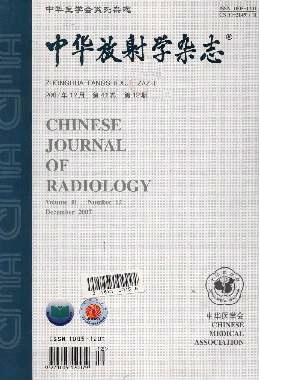Relationship between hemorrhagic transformation and angiographic early venous filling following mechanical thrombectomy for acute ischemic stroke
Q4 Medicine
Zhonghua fang she xue za zhi Chinese journal of radiology
Pub Date : 2020-01-10
DOI:10.3760/CMA.J.ISSN.1005-1201.2020.01.009
引用次数: 0
Abstract
Objective To explore the relationship between cerebral hemorrhagic transformation (HT) and angiographic early venous filling (EVF) following mechanical thrombectomy for acute ischemic stroke. Methods A retrospective imaging analysis was performed in the consecutive patients treated from January 2015 to November 2018 for acute anterior circulation large vessel occlusion using mechanical thrombectomy on the Affiliated Hospital of Yangzhou University. The demography, vascular risk factors and other clinical data of the patients were also collected. According to the experimental study of European Cooperative Acute Stroke Study Ⅱ (ECASS Ⅱ), the modified classification of HT after mechanical thrombectomy was divided into HT negative, HT-Ⅰ type and HT-Ⅱ type. The differences in EVF, clinical and demographic characteristics were compared. Multivariate logistic regression analysis was used to identify the independent risk factors for HT and clinical outcome. Diagnostic test characteristics of EVF for HT-Ⅱ type were determined using a receiver operating characteristic curve (ROC) analysis. Results A total of 98 patients with acute ischemic stroke who received mechanical thrombectomy were enrolled, including HT negative in 48 cases (49.0%, 48/98), HT-Ⅰ in 40 cases (40.8%, 40/98) and HT-Ⅱ in 10 cases (10.2%, 10/98). Significant differences were noted in age, and incidence of atrial fibrillation, EVF and poor outcomes among three groups (P<0.05). Multivariate logistic regression analysis showed that EVF [odds ratio (OR) 5.960, 95%CI 1.750-8.960, P=0.001] and atrial fibrillation (OR 3.485, 95%CI 1.962-18.986, P=0.028) were risk factors for the occurrence of HT-Ⅱ after mechanical thrombectomy. No risk factor for HT-Ⅰ was noted. Baseline National Institute of Health Stroke Scale (NIHSS) score (OR 1.162, 95%CI 1.021-1.345, P=0.038), EVF (OR 5.358, 95%CI 1.665-13.653, P=0.006) and HT-Ⅱ (OR 1.326, 95%CI 1.226-2.038, P=0.032) were independent risk factors for poor outcomes. And the sensitivity and specificity of EVF in prediction for HT-Ⅱ were 80.0% and 86.4% respectively, with the area under the ROC curve of 0.832. Conclusion Presence of EVF after mechanical thrombectomy may be the predictor for HT-Ⅱ, which indicates the poor clinical outcomes for acute ischemic stroke patients. Key words: Brain infarction; Radiology, interventional; Postoperative complications; Risk factors; Thrombectomy急性缺血性脑卒中机械取栓术后出血转化与血管造影早期静脉充盈的关系
目的探讨急性缺血性脑卒中机械血栓切除术后早期静脉充盈(EVF)与脑出血转化(HT)的关系。方法对2015年1月至2018年11月在扬州大学附属医院接受机械血栓切除术治疗的急性前循环大血管闭塞患者进行回顾性影像学分析。还收集了患者的人口学、血管危险因素和其他临床数据。根据欧洲急性卒中合作研究Ⅱ(ECASSⅡ)的实验研究,将机械性血栓切除术后HT的改良分型分为HT阴性型、HT-Ⅰ型和HT-Ⅱ型。比较EVF、临床和人口统计学特征的差异。多变量逻辑回归分析用于确定HT和临床结果的独立危险因素。采用受试者工作特性曲线(ROC)分析法测定EVF对HT-Ⅱ型的诊断试验特性。结果98例急性缺血性脑卒中患者行机械性血栓切除术,其中HT阴性48例(49.0%,48/98),HT-Ⅰ40例(40.8%,40/98),HT-Ⅱ10例(10.2%,10/98)。三组患者年龄、房颤发生率、EVF及不良预后差异有统计学意义(P<0.05)。多因素logistic回归分析显示,EVF(OR)5.960,95%CI 1.750-8.960,P=0.001)和房颤(OR 3.485,95%CI 1.962-18.986,P=0.028)是机械血栓切除术后HT-Ⅱ发生的危险因素。没有发现HT-Ⅰ的危险因素。国家卫生研究所卒中量表基线评分(OR 1.162,95%CI 1.021-1.345,P=0.038)、EVF(OR 5.358,95%CI 1.665-13.653,P=0.006)和HT-Ⅱ(OR 1.326,95%CI 1.226-2.038,P=0.032)是不良预后的独立危险因素。EVF预测HT-Ⅱ的敏感性和特异性分别为80.0%和86.4%,ROC曲线下面积为0.832。结论机械性血栓切除术后EVF的存在可能是HT-Ⅱ的预测因素,这表明急性缺血性脑卒中患者的临床预后较差。关键词:脑梗塞;放射学、介入学;术后并发症;风险因素;血栓切除术
本文章由计算机程序翻译,如有差异,请以英文原文为准。
求助全文
约1分钟内获得全文
求助全文
来源期刊

Zhonghua fang she xue za zhi Chinese journal of radiology
Medicine-Radiology, Nuclear Medicine and Imaging
CiteScore
0.30
自引率
0.00%
发文量
10639
 求助内容:
求助内容: 应助结果提醒方式:
应助结果提醒方式:


